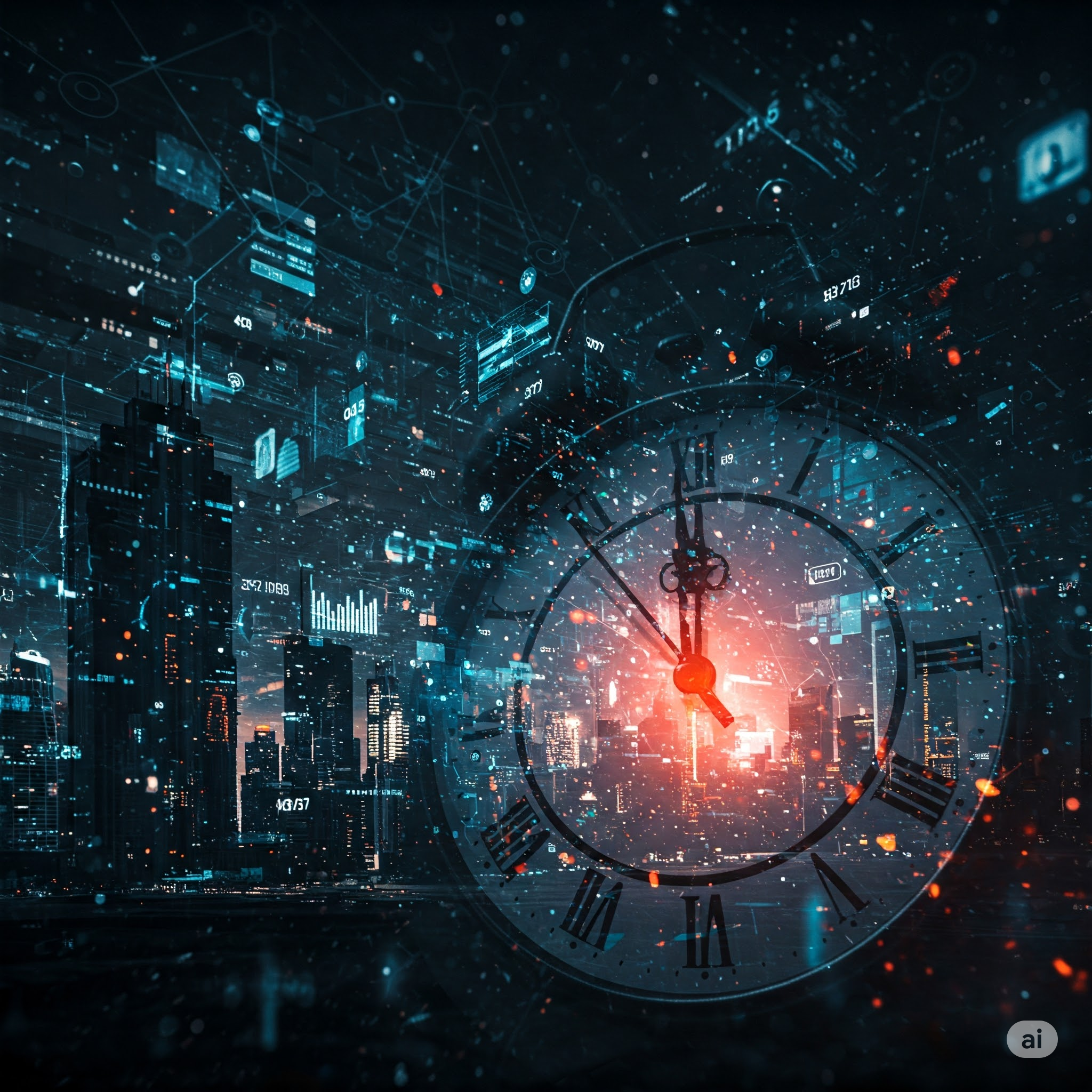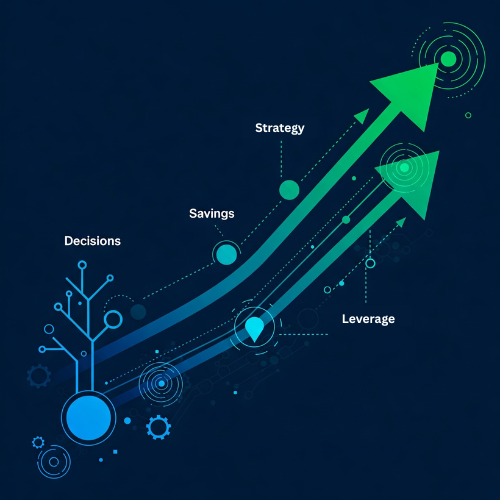I can still clearly recall the precise moment I realized we were all in trouble.
It wasn’t at some futuristic technology conference. I was sitting in a zoom meeting with a creative director I’ve known for years on a Tuesday afternoon last fall when I saw a change in his face as he tried out an AI tool for the first time.
He said silently, “That would have taken my team three days”
We must speak openly and honestly. Because that moment continues to unfold across sectors more quickly than most people are prepared to admit.
The “Not My Job” Fallacy
I encounter experts on the regular who say something along the lines of “AI is interesting, but it won’t really affect my job or industry.” or: “Sure, AI will change things eventually, but we’ve got years before we need to worry about it.”
I can relate to the sentiment. It is consoling. It’s dangerously incorrect, though.
The owner of a marketing business I recently spoke with was certain that AI couldn’t duplicate the “creative human touch” his staff adds to campaigns. I pulled out Claude and came up with some campaign ideas for his client’s products while we were speaking.
His confidence visibly crumbled.
“But this still needs human refinement,” he argued.
It does, for the time being. However, the gap is narrowing more quickly than most of us can tolerate.
The Timeline Delusion
I think the “we have time” myth is the most common pervasive misconception I come across. Although company executives see AI’s potential, they greatly overestimate the timeline for disruption.
This is a sobering reminder that the AI that will revolutionize your company won’t be available for another ten years. That won’t happen in five years. Most of the time, it has already arrived or will do so very soon. The acceleration is exponential rather than linear. Over the next 12 months, we’ll probably see more progress than we have in the previous five years.
Think about the transformations that have already occurred:
- By 2021, it was simple to tell the difference between human and AI-generated content. By 2023, the majority of casual readers could hardly tell the difference, hence AI detectors became a thing.
- AI algorithms can now review legal documents more quickly and accurately than teams of young lawyers used to be able to.
- AI is being used to handle 60–80% of customer service inquiries in customer service centers that once employed hundreds of people.
- With generative AI technologies, design processes that used to take days now just take minutes - take a look at tools like V0 or Lovable for example.
I have direct experience with these changes. They aren’t speculative.
Sorry to say this .. Your Expertise Isn’t as Unique as You Think
“My job requires nuanced judgment and years of specialized knowledge,” professionals tell me. “AI can’t replace that.”
This perspective ignores two fundamental facts about AI:
First, AI systems are not trying to replicate your entire job function, they’re breaking it down into constituent tasks and automating them one by one.
Second, and perhaps even more sobering: no individual human can come close to competing against the huge and collective knowledge AI has been trained on.
Modern AI systems have absorbed more professional content than any human could consume in dozens of lifetimes. They’ve effectively read millions if not even billions of legal briefs, financial analyses, marketing campaigns, architectural designs, and medical journals. They’ve studied your work and the work of countless professionals across every imaginable specialization.
It’s not a fair fight. It never was.
What AI Actually Threatens
The real threat isn’t necessarily complete job elimination (though that will happen or is happening in many cases). It’s:
-
Productivity multiplication: When one person + AI can do the work of 5-10 without it.
-
Skill commoditization: When previously rare expertise becomes available with a couple of questions using ChatGPT and the likes.
-
Value chain compression: When multiple specialized roles are compressed into fewer positions with AI as a helper.
-
Knowledge asymmetry: When AI’s access to collective human knowledge outpaces any individual’s ability to compete on information alone.
This isn’t a theory. Companies are adapting now: Marketing agencies are removing specialist positions. Accounting firms maintaining the same client load with reduced staff. Design agencies complete in hours what used to take weeks.
Who’s Actually Paying Attention
While many are in denial (no judgment, I was for a chunk of time), forward-thinking organizations are quietly reconstructing their operations around AI capabilities. They’re not waiting for everything to be perfect, they’re integrating today’s AI while building tomorrow’s infrastructure.
These companies understand something crucial, which is this .. the competitive advantage gained by early adopters will likely compound over time, creating gaps that become almost impossible to close.
Consider that:
- The financial institution that implements AI-driven risk assessment gains immediately better results and accumulates proprietary data that makes their system and their own custom AI models even more accurate.
- The manufacturer using AI to optimize supply chains builds tremendous amount knowledge that compounds with each decision cycle.
- The healthcare provider using AI diagnostics, over time develops workflows and integration expertise that creates advantages that would allow them to be profitable while cutting costs and.
The gap is growing faster and faster every day.
The Taste Advantage
But there’s an advantage we have as humans, which is our human taste—perhaps the most undervalued human advantage in an AI-dominated landscape.
As AI makes creation more accessible, the ability to discriminate between what’s just adequate and what’s truly exceptional becomes really valuable. Taste isn’t just subjective preference; it’s cultural intelligence as we move through time and space, emotional Reasoning, whether something feels right or not, and contextual understanding that AI struggles to replicate.
Consider:
- The creative director who can instantly recognize which of 50 AI-generated concepts will genuinely move an audience .. feels right type thing.
- The product designer who intuitively understands which features will delight rather than merely satisfy.. looks appealing to our liking as humans.
- The curator who can identify the emerging trend before the data makes it obvious .. the 6th sense as some call it ;)
These taste-based judgments incorporate subtle cultural signals, emotional intelligence, and our lived human experience that AI systems, although capable of much but cannot fully internalize.
I’ve observed this firsthand in meetings where teams struggled to select from among dozens of design options generated by AI. The person who could confidently select which option would be the right one for the customers and the emotional reasoning behind it became the most valuable voice in the room.
The reason I say all of this, is because in an Era with content and generation of text, code, designs, etc .. what do you think would distinguish one product from another, or one blog post from another, or one video from another? It’ll boil down to how does it sit with the person seeing it, or engaging with it.
The Path Forward
If I’ve made you uncomfortable, I’ve done my job really well here. Complacency is the greatest threat in periods of technological disruption, we’ve seen something similar with the invention of the internet, this is at least 50x the impact if note more.
Look, I’m not immune to this, I’m just as scared as you are. I’ve had moments wondering if what I do will matter in five years. But what’s happening to me is also happening to you .. We’re all navigating this transformation together.
But this isn’t a message of doom, it’s a call to action, act now. The businesses and professionals who thrive won’t be those who resist AI, or those who are skeptical, but those who become really proficient at leveraging it.
Here’s where to start:
-
Audit your value chain: Analyze every process in your business and identify which areas are most vulnerable to AI automation in the next 12 months. you’d be surprised that many of these automations are already here with agentic AI.
-
Develop institutional AI literacy: This isn’t about everyone becoming technical experts. It’s about understanding AI’s capabilities and limitations well enough to identify strategic opportunities, make it a requirement that each member of the team should use AI, even if it’s’ just making it their home page on their browser.
-
Experiment aggressively but deploy carefully: The cost of not exploring AI applications is huge compared to the cost of unsuccessful experiments. Budget for continuous learning, check out this article to know how we can help you achieve that.
-
Redefine roles around AI leverage: The most valuable employees will be those who can amplify their impact by directing and collaborating with AI systems, don’t be scared of promoting those individuals and moving them to a different role structured around AI, because they’re on their way to 10x their productivity and impact.
-
Focus on distinctly human value: Double down on the aspects of your business that rely on genuine human connection, ethical judgment, and cultural understanding.
-
Cultivate taste and discernment: In a world where AI can generate endless options like we said earlier, the ability to select what’s truly excellent becomes invaluable, use your intuition.
A design director I know recently told me: “Before AI, our value was tied to us making things and how fast we can make them. Now, our value is in knowing which of these things really matter.” That shift from creation to curation is happening everywhere I look, if you haven’t noticed you will really fast?
The Bottom Line
The greatest risk isn’t AI itself, it’s the failure to recognize how rapidly it’s changing and improving, and how deeply it will transform businesses across every sector, yes EVERY sector.
The question isn’t whether AI will disrupt your industry. The question is whether you’ll be a disruptor or a disrupted.
The choice, for now, remains yours.
But the window for making that choice is closing faster than most people realize, that’s why we’re here to help you integrate AI Systems throughout your business.
BTW that sound you hear? … It’s the clock ticking.
Tags
Rafat Alhawash
CEO

